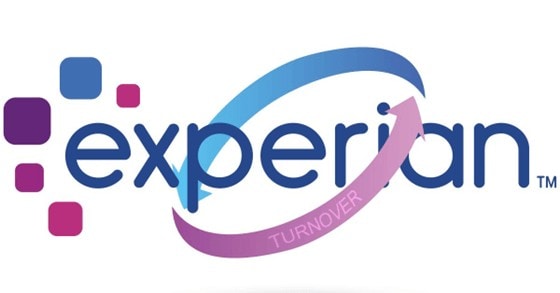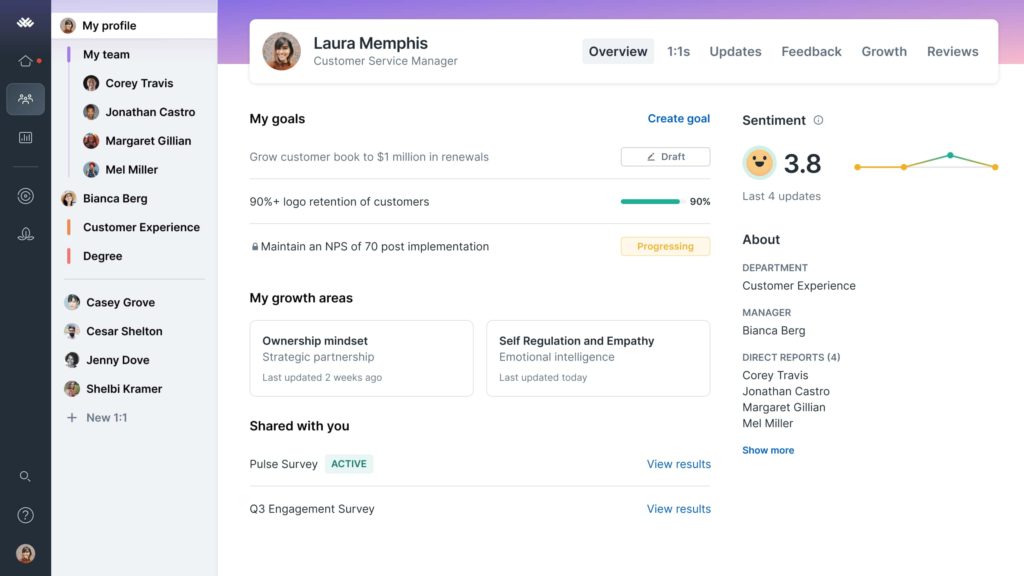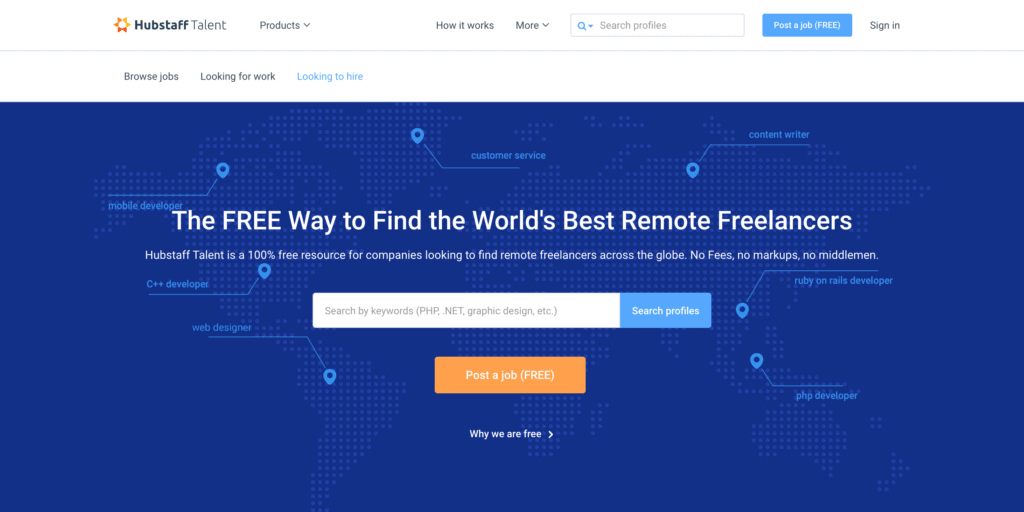Workforce analysis is an increasingly popular buzzword in the human resources and corporate space. But what purpose does it actually serve for growing businesses?
In this post, we’ll explore strategies, tools, and metrics for understanding your current workforce. But first, let’s explore what workforce analysis means to the modern workforce.
Subscribe to the Hubstaff blog
What is workforce analysis?
Workforce analysis is a process corporations use to gather, analyze, and interpret data to accurately assess the current state of their employees, growth, new skills, and organizational health.
When businesses conduct workforce analysis, human resource management can turn data into action points for planning business KPIs and labor projections.
Ultimately, this data can be used to make informed decisions regarding retention, hiring, and talent management. In fact, the world’s largest brands utilize workforce analysis and find its insights crucial to their workforce success.
Is workforce analysis the same as workforce analytics?
The terms are often interchangeable because each supports the other. Workforce analytics data is applied to recruitment, retention, and talent management. Workforce analysis relies on solid analytical metrics to provide leadership with clear insights and planning.
The importance of conducting workforce analytics in human resources
What does measuring workforce analytics enable businesses to understand? Here are some of the key insights businesses can obtain and the challenges they can address:
- Forecasting which employees will be high performers to manage their retention
- Identifying top talent for promotion and succession planning
- Matching potential hires with the organizational needs of the business
- Recruiting candidates who match your work culture
- Understanding employee engagement and job satisfaction utilizing big data
- Monitoring and alerting leadership about compensation rates and pay raises
- Workforce planning and skill gaps to ensure a well-staffed and productive organization
- Planning for retirements within the organization and ensuring high-level positions will be filled
- Reducing or managing high turnover rates
- Utilizing automation to reduce excessive administrative tasks and HR costs
- Creating a profile of how an organization’s workforce will look in the future if the suggested changes are not made
What are some examples of workforce analysis?
When talking about workforce analysis, the main terms you will hear are supply analysis, demand analysis, and gap analysis. Let’s look at these three subcategories and what each means for the workforce planning process.
1. Supply analysis
Supply analysis involves assessing the organization as it is. This includes the number of employees, demographics, competencies, and skillsets. It then makes supply projections based on the terminations, resignations, retirements, and promotions that have already occurred.
In short, you can think of supply analysis as how your future workforce would look if you were to do nothing.
Example: Every year to date, 6% of your organization has resigned. If your company grows its staff to 10,000 and this ratio continues, you will lose 600 employees each year.
2. Demand analysis
Demand analysis goes deeper than supply analysis. It looks at factors like new product launches, competitors, and overall market conditions. It can also consider industry-specific triggers like new regulations, which could help or hurt your business.
This analysis model looks both externally and internally to match the future of your business with the workforce you need to hit your business KPIs.
Example: A UK financial regulator like the FCA plans to implement new regulations governing banks and fintechs. You plan to launch software that facilitates this requirement for your financial services customers.
You can expect and predict an uptick in orders that will ultimately lead to increased staffing requirements in specific areas of your business.
3. Gap analysis
Gap analysis pulls together the supply and demand analysis and compares them. It analyzes the gaps between what you have now and what you will need in the future.
For instance, you might need fewer employees, more well-rounded employees, or more senior hires. Gap analysis can also categorize future scenarios based on which ones are most urgent or most likely to happen.
Example: Taking the figures we quoted above:
If 6% of your organization leaves each year, but you’re launching a new product, you might be too short-staffed to find success.
You’d then need to adjust and hire the type of employees necessary to facilitate future launches. Then you could work on the recruitment and retention of these employees.
Case study of workforce analysis
High employee turnover at Experian was a problem, and the company noted during business strategy exercises that turnover levels were 3-4% higher than they wanted.
By utilizing workforce planning, they predicted 200 factors, including the size of teams, structure, supervisor performance, and even the length of employee commutes. They were then able to identify tangible risk factors and future needs.
For instance, when someone moved further from the office, they were more likely to resign. They also found that teams of more than 12 people tended to see a higher drop-off. (Source)
How to conduct workforce analytics
Today, leading HR managers and organizational directors rely on workforce analytics to guide their decisions. However, data alone holds little meaning without a clear action plan.
To make workforce planning work for your organization there are some basic steps to follow.
1. Start with a workforce question or challenge that key stakeholders want to resolve
It’s essential to get stakeholder buy-in and a good understanding of short and long-term business KPIs.
One workforce strategy question might be: are we equipped to deal with the launch of new products in Asia over the next five years?
By identifying key workforce questions or challenges, you can determine which data sets you need and how you will find and track them.
2. Identify the information that your senior management team needs to make decisions
Following the previous example in point 1, you might need to conduct an analysis of the Asian competitors and target demographics. Then, you could report on the support and technical staff needed to serve this demographic.
Of course, you will need strong data from key stakeholders who manage this region and the development of your products.
3. Decide on the end goal
Now you have your question and your data. The next step is to understand what the end goal is.
In this case, it might be adequately supporting the Asia market without overspending or underspending on your workforce.
It could also be a benchmark based on customer satisfaction or product sales in that region.
Notice that these are tangible, measurable goals. This is key because a vague goal will lead to vague reporting and less meaningful results.
4. Decide what software you will use for analysis, reporting, and performance management
Once you’ve understood the type of data you want to analyze, you need to decide on software.
If you have more than ten employees, manually importing data into Excel isn’t going to be a good use of your time. It will also be difficult to draw conclusions from these results.
Another thing to keep in mind is that manual methods are prone to error. As we all know, humans make mistakes. They’re only human!
There are plenty of different workforce analysis software packages available. Here are a few of them:
Planful
Planful offers accurate workforce plans, reports, and insights with colorful easy-to-understand visuals. Remember, presentation is just as important as analysis. Department heads and stakeholders need to understand conclusions and action points regarding human capital decisions and strategic objectives.

Lattice
Lattice lets you draw insights to make data-driven, people decisions. By pulling in Pulse surveys, you’ll have an accurate way to gauge business growth, staffing levels, workforce needs, and department performance.
IBM Workforce Planning
IBM Workforce Planning helps you acquire and retain the right talent at the right time. Powerful analytics and HR tools can help you take the necessary steps towards more effective workforce planning.
Hubstaff
It goes without saying that Hubstaff is an excellent tool for workforce analysis. The workforce management software suite provides users with proof of work, time-tracking software, and payroll management. You can even go a step further and utilize Hubstaff Tasks project management software to take workforce management to new heights.
Conclusion
In this post, we mainly discussed the benefits of workforce analysis in terms of hitting financial projections and staffing costs — but there are even more advantages.
Beyond recruitment strategies and elaborate business plans, workforce analysis can be a major contributor to helping you craft your ideal company culture.
Whether it’s achieving gender and racial diversity or eliminating discrimination or bullying, analytics can help. But, as workforce analytics technology becomes increasingly prominent, don’t lose sight of the people themselves. They’re the key to the future success of your organization.
Subscribe to the Hubstaff blog for more posts like this
Most popular
Timekeeping Integrity: Strategies to Combat Timesheet Fraud
Just like the old saying goes, honesty really is the best policy — especially when it comes to filling out your timesheet. Times...
What Is Deep Work and How to Implement It
With smartphones, social media, and an increasingly distracted world, it’s increasingly rare for anyone to reach deep concentrat...
How to Build a Remote Team: A Comprehensive Guide
32.6 million Americans will work remotely by 2025. These numbers highlight how popular remote work opportunities are, but learning...
The MoSCoW Prioritization Method: Streamlining Project Management
Prioritization is the name of the game with the MoSCoW prioritization method, helping teams sort their work by importance to compl...








